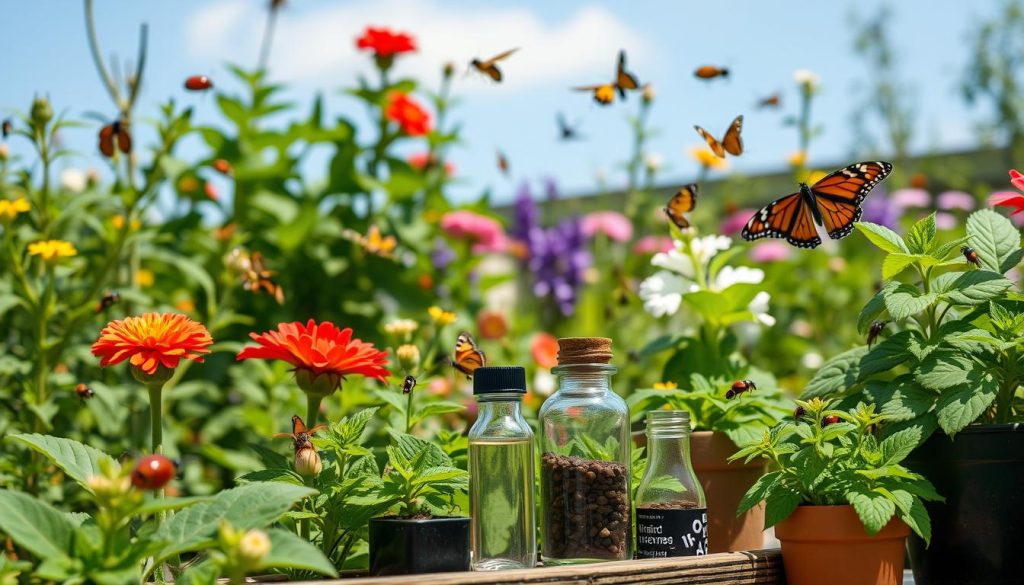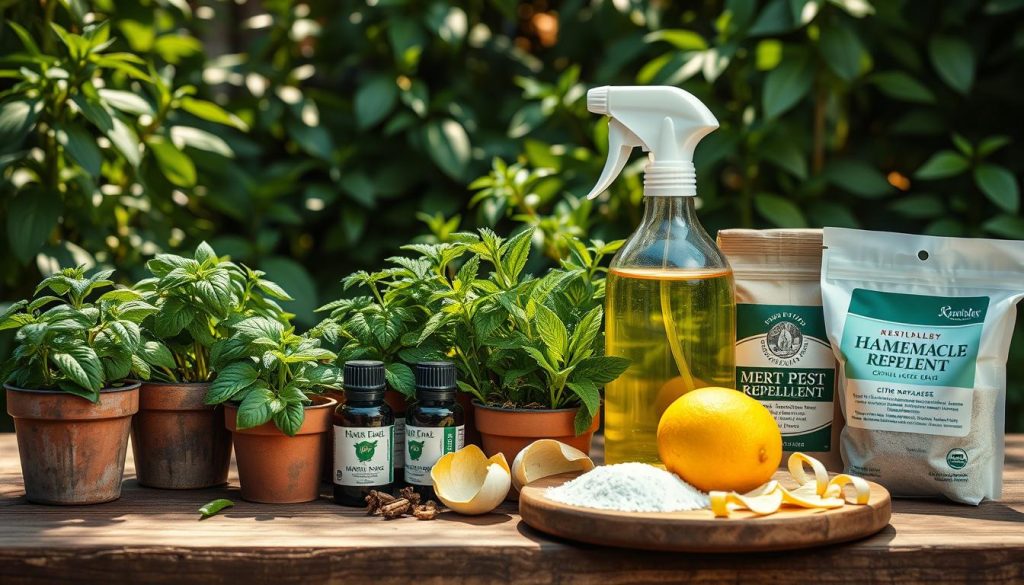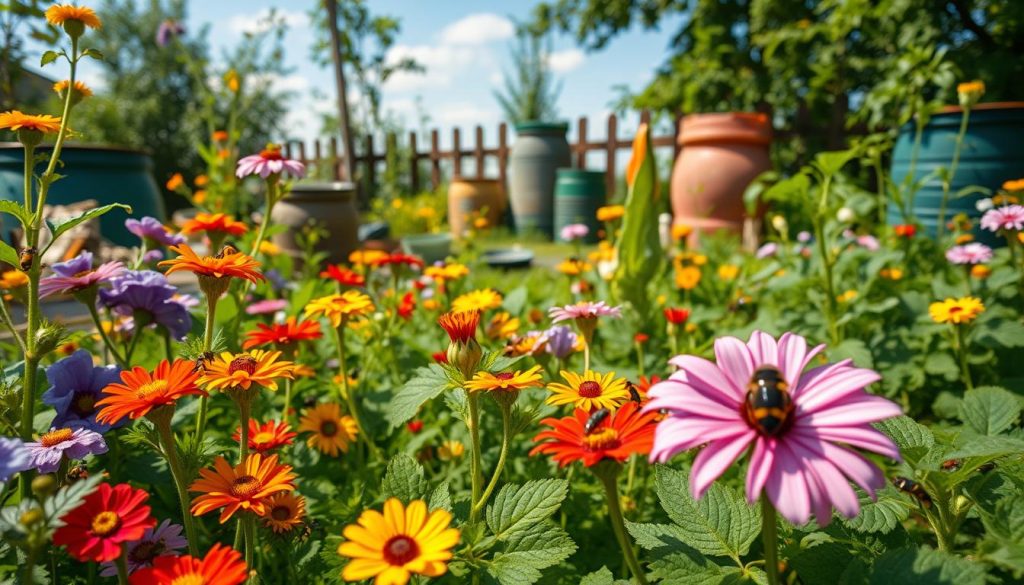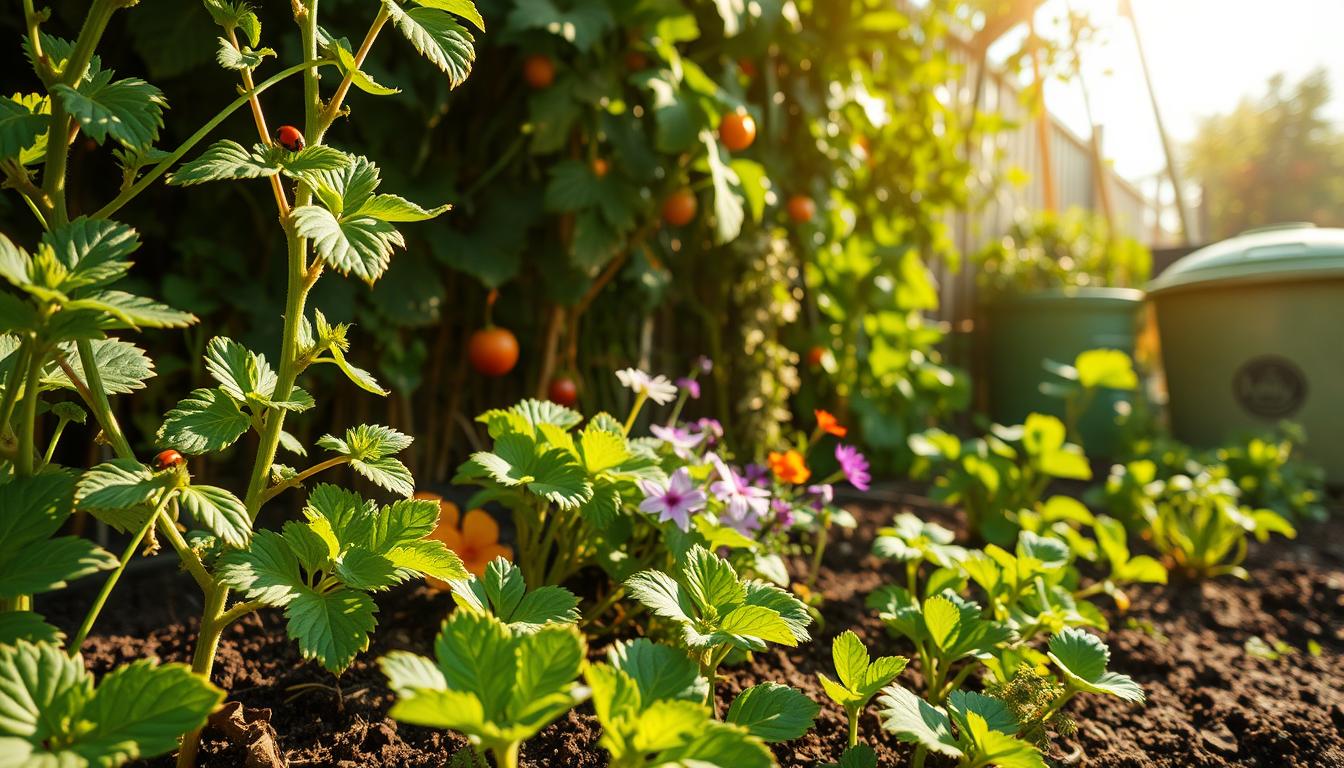I’m excited to share my favorite organic pest control methods. They’ve helped me keep my home healthy and eco-friendly. I value sustainable living and have tried many natural and non-toxic methods to keep pests away.
Using organic pest control methods and eco-friendly pest management is key. I’ve found that natural pest repellents work just as well as traditional methods. They’re also better for the environment. In this article, I’ll show you how to keep your home pest-free using these methods.
Understanding the Importance of Organic Pest Control
Exploring organic pest control shows its value for my home. It ensures a healthier space and uses safe, sustainable methods. Choosing organic pest control means less chemical risk and a safer home for my family and pets.
Some key benefits of organic pest control include:
- Reduced risk of chemical exposure
- Creation of a safer living environment
- Effective and sustainable pest solutions
Why I Choose Organic
I prefer organic pest control because it’s a healthier choice. It’s free from harsh chemicals and works well. This makes it a great option for my family and pets.
Benefits for My Family and Pets
Organic pest control keeps my family and pets safe from harmful chemicals. It’s a smart choice for their health. Here are some benefits:
| Benefits | Description |
|---|---|
| Reduced risk of chemical exposure | Organic pest control methods reduce the risk of chemical exposure, creating a safer living environment. |
| Healthier environment | Organic pest control methods provide a healthier alternative to traditional pest control methods, creating a healthier environment for my family and pets. |

Common Pests in My Home
To keep our homes pest-free, we need to know the common pests. Understanding these pests helps us prevent them with green methods. Ants, cockroaches, and rodents are often found in homes.
Preventing pests is easier with holistic methods. Sealing entry points and keeping our homes clean helps. Natural repellents are also effective in managing pests.
Identifying Household Pests
- Ants: look for small trails of ants near food sources
- Cockroaches: check for droppings or egg shells in dark, moist areas
- Rodents: listen for scratching sounds or notice gnaw marks on furniture
Seasonal Pest Issues
Seasonal pests change with the seasons. Ants and cockroaches are more common in summer. Rodents are more active in winter. Knowing this helps us prepare and prevent pests with safe methods.

Natural Repellents I Use
I’ve been looking into organic pest control and found natural repellents are key. They help keep my home healthy without using harmful chemicals. Using non-toxic methods means I can protect my family and pets better.
Essential oils like peppermint, lemongrass, and tea tree oil are great at keeping pests away. You can diffuse them or mix with water for a spray. I also use a garlic and pepper spray to repel pests without harming the environment. It’s simple to make and targets pests in specific areas.
Essential Oils for Pest Control
- Peppermint oil: known for its strong scent, which can repel ants and spiders
- Lemongrass oil: has a citrusy scent that can repel mosquitoes and flies
- Tea tree oil: has antifungal and antibacterial properties, making it effective against a wide range of pests

Garlic and Pepper Spray
This homemade spray is easy to make and works well against pests. It’s made from garlic, pepper, and water. It’s safe for the environment and a good choice over chemical pesticides.
| Ingredient | Quantity |
|---|---|
| Garlic | 3 cloves |
| Pepper | 1 teaspoon |
| Water | 1 liter |
Using these natural repellents makes my home healthier and more sustainable. They’re safer for my family and pets. Plus, they reduce my need for harmful chemicals.
Beneficial Insects I Encourage
I’ve learned how important beneficial insects are for a balanced ecosystem. They help me avoid using harmful pesticides. Ladybugs and lacewings are great at controlling pests, making my garden healthier.
Ladybugs and Their Benefits
Ladybugs eat aphids and other pests, which is super helpful. To attract them, I grow flowers like marigolds and sunflowers. I also skip using pesticides to protect these helpful bugs.
Lacewings as Natural Predators
Lacewings are great at fighting pests like whiteflies and aphids. To draw them in, I plant flowers like angelica and dill. I also make sure they have a safe place to live and eat.
Here are some ways to attract beneficial insects:
- Plant a mix of flowers that offer nectar and pollen.
- Stay away from pesticides to protect these insects.
- Make your garden welcoming with shelter and food.
By doing these things, I’ve made my garden a better place. It’s healthier and doesn’t need as many pesticides. This eco-friendly approach works well for me.

Homemade Traps That Work
I’ve been looking into organic pest control and found homemade traps are great. They catch pests without harsh chemicals. This way, I can keep my home healthy without using harmful pesticides.
Homemade traps are safe for families with pets or young kids. They’re a good choice because they don’t use chemicals.
To make these traps, I use things like fruit, vinegar, and soap. For instance, a DIY fruit fly trap uses apple cider vinegar in a jar. Cover it with plastic wrap, then poke holes in it. Fruit flies get trapped by the vinegar smell.
DIY Fruit Fly Traps
- Fill a jar with apple cider vinegar
- Cover the top with plastic wrap
- Poke small holes in the plastic wrap
Crafting Simple Ant Traps
Making an ant trap is easy. Mix sugar, water, and borax to create a paste. Ants will be drawn to it. Place it near where ants enter, and they’ll take it back to their colony, solving the problem.
Using these homemade traps keeps my home pest-free without harsh chemicals. They’re not just effective but also good for the environment. This makes them a top choice for organic pest control.
The Role of Diatomaceous Earth
Diatomaceous earth is a natural, non-toxic substance that helps control pests. It’s a key part of sustainable pest solutions. It’s safe for the environment and doesn’t harm it. Using it, we can keep pests away without harming our planet.
I use diatomaceous earth to repel and kill pests as part of my green pest control. It’s a simple and effective method. I combine it with other natural methods for a complete pest control plan.
How I Use Diatomaceous Earth
I apply diatomaceous earth in different ways, including:
- Applying it directly to pest-infested areas
- Mixing it with water to create a spray
- Using it to repel pests in my garden
Safety Precautions
While diatomaceous earth is generally safe, there are safety steps to take. It can be harmful if inhaled, so wearing a mask is crucial. It can also cause skin irritation in some, so handle it carefully.
Companion Planting in My Garden
I use companion planting to balance my garden’s ecosystem. This method pairs plants to boost their growth and fight pests. It’s a green way to keep my garden healthy without using harmful chemicals.
By picking the right plants, I attract good bugs and cut down on pest control needs. For instance, marigolds keep nematodes away from tomatoes. Basil makes lettuce taste better and keeps aphids off. This approach helps my garden grow strong and healthy.
Plants I Pair for Pest Management
- Marigolds with tomatoes to repel nematodes
- Basil with lettuce to improve flavor and repel aphids
- Radishes with cucumbers to repel cucumber beetles
I also work on improving soil health with organic methods. This way, I can lower pesticide use and keep my garden in top shape. It’s a green way to enjoy a lush garden while caring for our planet.
Organic Sprays I Create
I’ve found making my own organic sprays is a great way to keep pests away without harming the planet. Using natural pest repellents, I can keep my home pest-free without using toxic chemicals. Neem oil is a powerful natural pest repellent that I use to make a non-toxic spray.
Recipe for Neem Oil Spray
To make a neem oil spray, I mix neem oil with water and a bit of soap. This spray is great for keeping away insects and mites. Here’s a simple recipe to try:
- 2 tablespoons of neem oil
- 1 quart of water
- 1 teaspoon of mild soap
Other Effective Spray Options
There are other effective sprays for non-toxic pest control too. Options like garlic spray, pepper spray, and soap spray work well. These sprays can keep away pests like ants, aphids, and whiteflies. Using these natural repellents helps me keep my home pest-free without harming the environment.
The Importance of Cleanliness
Cleanliness is key to keeping pests away. Using organic pest control helps keep my home healthy. Regular cleaning, like vacuuming and dusting, gets rid of pests and keeps them out.
Regular Cleaning Practices
I stick to a cleaning routine to keep my home pest-free. Daily tasks include wiping surfaces and sweeping floors. Weekly, I vacuum and dust. I also use green pest control products to clean and disinfect.
Decluttering to Deter Pests
Decluttering is crucial for a pest-free home. Less clutter means fewer hiding spots for pests. I use green solutions, like sealed food containers, to keep pests away.
Here are some tips for a pest-free home:
- Store food in sealed containers
- Keep floors and surfaces clean and dry
- Eliminate clutter and keep your home organized
- Use eco-friendly pest management products
Monitoring and Prevention Techniques
To keep pests away, it’s key to use holistic pest prevention. Check your home and yard often for signs like droppings or damage. Early detection helps prevent bigger problems.
Using safe pest management is important for your family and the planet. Green pest control methods, like introducing beneficial insects, are a good start. Here are some tips to help:
- Regularly inspect your home and yard for signs of infestation
- Seal entry points to prevent pests from entering your home
- Keep your home clean and clutter-free to reduce the attractiveness to pests
- Use natural repellents, such as essential oils or garlic, to deter pests
By following these tips, you can cut down on pesticide use. This helps keep your ecosystem healthy. Always choose safe and green pest control methods to protect everyone and the environment.
When to Consult a Professional
My organicpest control methodshave worked well at home. But sometimes, I need to call a pro. If I’ve tried manyeco-friendly pest managementways and still face a big problem, it’s time to get help from asustainable pest solutionsexpert.
It’s important to know when a pest issue is serious. Look for signs like a lot of damage, widespread pests, or pests that carry diseases. A professional can spot the problem and come up with aorganicplan to get rid of them.
When searching for aorganic pest controlservice, I look foreco-friendlyandsustainableoptions. I research and read reviews to find a service that fits my values. This way, I can keep my home healthy and pest-free.

